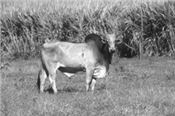Select Heat Tolerant Cattle

ERIN LARIMORE
JACKSON, MO.
Cattle that match their environment are more productive, less stressed, and are more effective at utilizing the resources available to them. Bottom line, matching cattle genetics to the production environment is profitable.
In Missouri, we need to select cattle that are heat tolerant and are able to graze toxic fescue without suffering production losses. The current tools available to breed cattle adapted to hot temperatures with high humidity levels is a short list.
• Introduce Bos indicus breeds into the herd
• Select cattle that shed their winter coat in early spring or summer
The ability to shed the winter coat early is an effective predictor of a cow’s ability to cope with heat stress. Calves from cows that shed their winter coat weigh more at weaning. Cattle with enhanced ability to shed hair can potentially tolerate fescue toxicosis better.
A hair shedding score is easy to evaluate and is a free management practice for producers to utilize. You may be able to identify genetic lines of cattle that have an increased ability to shed hair since there is a moderate heritability of hair shedding.
Shedding scores should be taken in spring or early summer and are scored on a 1 to 5 scale. A score of 5 indicates an animal that still has its complete winter coat with no evidence of shedding. A score of 1 is a completely slicked-off animal.
MU researchers are working on genetic predictions of hair shedding, but these predictions are not available yet. Until then, producers in hot, humid environments should consider a hair shedding score as one part of their selection criteria. Earlier shedding cattle are better suited for these environments and will be more productive and profitable. ∆
ERIN LARIMORE: Livestock Specialist, University of Missouri